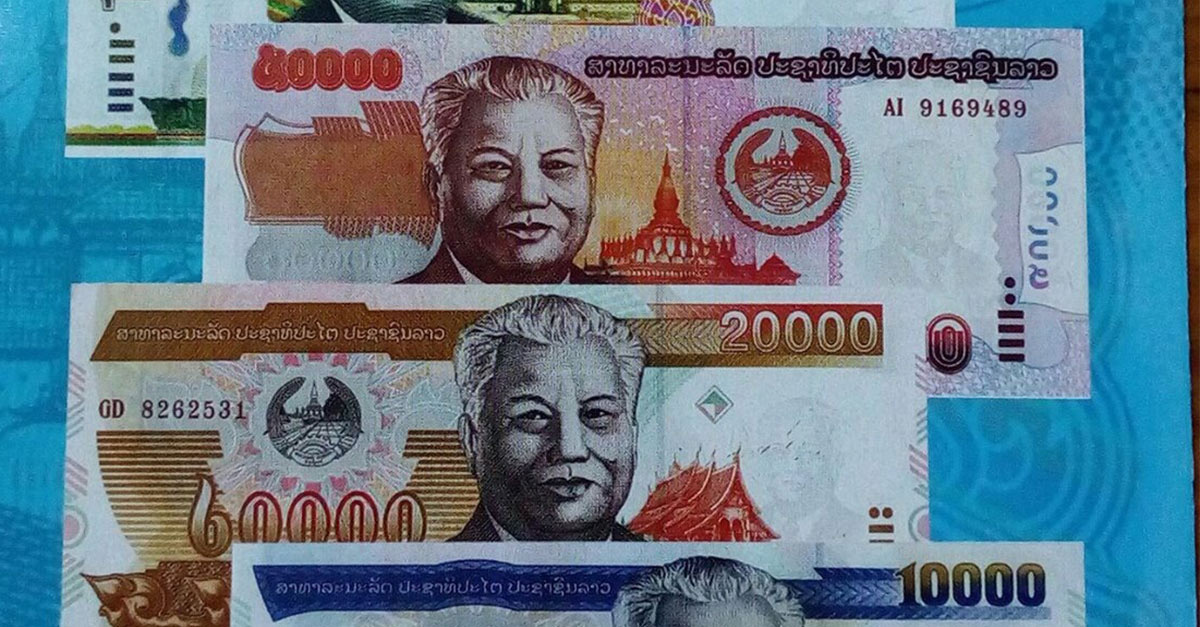The central bank of Laos (Bank of Laos) has issued public leaflets detailing how to tell if the banknotes we are using are fake. Fortunately, authentic kips are quite easy to spot if one knows where and how to look.
10,000 kip banknote
Real: Authentic banknotes use a special type of material made from a blend of cotton, rubber and fabric. This material makes for a cloth-like feel that is consistently coarse and slightly embossed (minutely raised) and textured when you run your fingers through it – Number 1 (especially the 10000 number) – Number 2. When holding up the note to the light, check for a very clear metallic silver security hologram line embedded into the paper with the number 10000 perfectly embedded into it, running vertically through the note – Number 3. Also, when holding the note to the light, a rather clear silhouette watermark of the late President Kaysone Phomvihane can be visibly observed from both sides – Number 4.
Fake: Counterfeiters typically scan real banknotes and color print them. The image is generally not as clear and quite blurred compared to the real thing. Fake notes generally are made from mainstream, standard white paper – Number 1. The paper will feel very smooth to the touch, without any coarseness whatsoever (check the 10000 number) – Number 2. The security hologram line will be very unclear and not well embedded into the paper; the 10000 number appears to be a separate image on top of the line – Number 3. The image of the late President is not very evident, when the note is held to the light – Number 4.
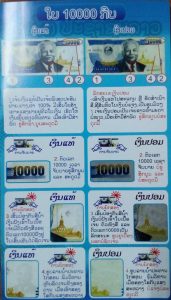
20,000 kip banknote
Real: Authentic banknotes use a special type of material made from a blend of cotton, rubber and fabric. This material makes for a cloth-like feel that is consistently coarse and slightly embossed (minutely raised) and textured when you run your fingers through it – Number 1. Look for a diamond shape on top of Wat Xiengthong; when held to the light, both sides (of the note) of this shape will appear to be perfectly aligned – Number 2. When holding the note to the light, a clear silhouette watermark of the late President Kaysone Phomvihane can be visibly observed from both sides – Number 3. Additionally, the ໒໐໐໐໐ (20000 in Lao numerals) will be very coarse to the touch – Number 4.
Fake: Counterfeiters typically scan real banknotes and color print them. The image is generally not as clear and quite blurred compared to the real thing. Fake notes generally are made from mainstream, standard white paper – Number 1. The diamond shape on top of Wat Xiengthong, when held to the light, will not be perfectly aligned and appear as unclear – Number 2. When holding the note to the light, a silhouette watermark of the late President Kaysone Phomvihane cannot be visibly seen from any side – Number 3. Lastly, the ໒໐໐໐໐ (20000 in Lao numerals) will be very smooth to the touch – Number 4.
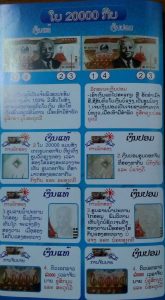
50,000 kip banknote
Real: Authentic banknotes use a special type of material made from a blend of cotton, rubber and fabric. This material makes for a cloth-like feel that is consistently coarse and slightly embossed (minutely raised) and textured when you run your fingers through it – Number 1 (especially the 50000 number that is right above the late President Kaysone Phomvihane’s shoulder) – Number 2. When holding up the note to the light, a rather clear silhouette watermark of the late President Kaysone Phomvihane can be visibly observed from both sides – Number 3. Also when held up to the light, the ໕໐໐໐໐ (50000 in Lao numerals) on both sides of the note will appear to be perfectly aligned – Number 4.
Fake: Counterfeiters typically scan real banknotes and color print them. The image is generally not as clear and quite blurred compared to the real thing. Fake notes generally are made from mainstream, standard white paper – Number 1. The paper will feel very smooth to the touch, without any coarseness whatsoever (note in particular the 50000 number right above the late President Kaysone Phomvihane’s shoulder) – Number 2. When holding up the note to the light, the silhouette watermark of the late President Kaysone Phomvihane will not be clear from any side – Number 3. In addition, when held up to the light, the ໕໐໐໐໐ (50000 in Lao numerals) on both sides of the note will be imperfectly aligned and the edges will appear slightly smudged – Number 4.
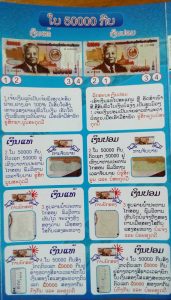
100,000 kip banknote
Real: Authentic banknotes use a special type of material made from a blend of cotton, rubber and fabric. This material makes for a cloth-like feel that is consistently coarse and slightly embossed (minutely raised) and textured when you run your fingers through it – Number 1. When the note is tilted, one can clearly see ໑໐໐໐໐໐ (100000 in Lao numerals) embedded in the silver metallic security hologram – Number 2. When holding up the note to a UV light, a rather clear silhouette watermark of the late President Kaysone Phomvihane can be visibly observed from both sides – Number 3. Additionally, the ໑໐໐໐໐໐ (100000 in Lao numerals) will be very coarse to the touch – Number 4.
Fake: Counterfeiters typically scan real banknotes and color print them. The image is generally not as clear and quite blurred compared to the real thing. Fake notes generally are made from mainstream, standard white paper – Number 1. When the note is tilted, one cannot clearly see ໑໐໐໐໐໐ (100000 in Lao numerals) embedded in the silver metallic security hologram – Number 2. When holding up the note to a UV light, a silhouette watermark of the late President Kaysone Phomvihane will not be visible observed from any side – Number 3. Additionally, the ໑໐໐໐໐໐ (100000 in Lao numerals) will not be slightly embossed and will feel very smooth to the touch – Number 4.
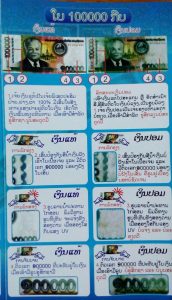
The Bank of Laos warns that producers and users of counterfeit notes and equipment used to make them are subject to incarceration under the laws of Laos. It has also provided recommendations on what to do when one encounters counterfeit notes.
- Do not, under any circumstance, use/spend the counterfeit note.
- Bring the counterfeit note to any of the following authorities: police, Bank of Laos, Foreign Exchange Department (Ministry of Finance).
- Upon encountering a person using counterfeit notes, take the time to advise him/her accordingly and if possible inform the appropriate authorities.
Contact information:
- Police: 1191
- Bank of Laos: 021 213 109
- Foreign Exchange Department: 021 223167, 021 243615
- Any commercial bank in Laos


